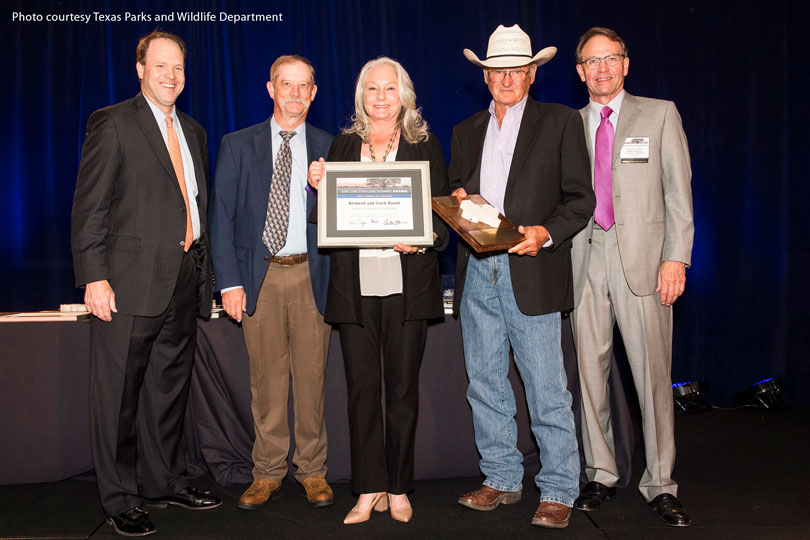By Gary Joiner
TFB Radio Network Manager
Deborah Clark says Eastern gamagrass—the queen of the prairie grasses—is her pride and joy.
“We think that she’s as beautiful as our grandchildren,” Clark said in an interview with the Texas Farm Bureau Radio Network.
Clark and her husband, Emry Birdwell, have been honored for their efforts and passion for habitat management and wildlife conservation on their Clay County ranch. They were recognized with a regional Lone Star Land Steward Award from the Texas Parks and Wildlife Department at a May 17 banquet in Austin.
Their ranch has been involved in active cattle operations since the 1930s, but it underwent major changes after they took ownership 13 years ago. Using high intensity and low duration grazing, they are able to maximize beef production and improve quail and other wildlife habitat at the same time.
The grazing management practices are closely tied to the wildlife resource management goals. There is a deliberate holistic context evidenced at the ranch.
“We run a really intense rotational system. We run about 5,000 cattle. This time of year during the growing season, we move them four or five times a day,” Birdwell, a Clay County Farm Bureau member, said. “We’re growing more grass and leaving more grass behind. We’ve increased the forbes and legumes. It all comes back, and it all aids in the wildlife.”
Birdwell said about 25 percent of the 14,000-acre ranch near Henrietta was bare ground when they acquired it. Now, he said, about 95 percent of the bare ground has been covered up as a result of management practices.
The ranch produces twice the county average of beef per acre and in less time. Plant diversity equals wildlife diversity.
“We bunch the cattle up in a real tight herd. The main thing that makes this thing work is herd impact and rest. We make sure the land recovers before we come back,” he said.
Clark noted there are years that are unforgiving, and there are years that are forgiving. She said you just have to have patience, tenacity, trust and faith.
“I think what we see with our eyes is the diversity of grasses and forbes that have come back onto the ranch. What we don’t see is the soil health that’s been regenerated and becoming more fertile that’s allowing us to have that diversity of grasses and forbes,” she said.
Wichita Falls officials also have their eyes on the Birdwell and Clark Ranch.
The city is pursuing a proposed Lake Ringgold in Clay County to meet its long-term water needs.
The reservoir would essentially cut the Birdwell and Clark Ranch in half and put other properties underwater.
“To the best of our knowledge, Lake Ringgold is still in the environmental studies phase. But with a group of friends who have come on board to help us, we really want to educate the north central Texas region that there’s more we can do about conserving water than we do about building another reservoir that’s going to cost a lot of money, a lot of taxpayer dollars,” she said. “And, indeed, the city of Wichita Falls has been in front of the effort to conserve water. If they will trust that, I believe we’ll have water for the region for years to come without building a reservoir.”

